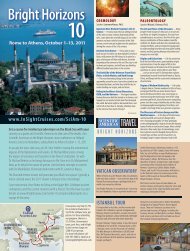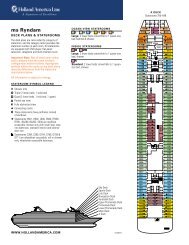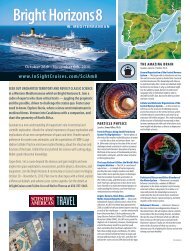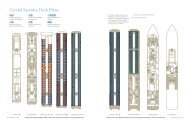You also want an ePaper? Increase the reach of your titles
YUMPU automatically turns print PDFs into web optimized ePapers that Google loves.
Mysteries of the <br />
Moon <br />
? <br />
Dave Stevenson <br />
Caltech <br />
“Sky and Telescope” <br />
Cruise, 2010
• Why is there only one planet with an Earthlike <br />
Moon? <br />
• Why is the Moon about the same apparent size <br />
as the Sun ? <br />
• Why is the nearside different from the far side? <br />
• Why does the moon have magneHc rocks? <br />
• Why are there moonquakes? <br />
• Is the moon dry? <br />
• Anything you would like explained?
Q. Why is there only one planet with an Earthlike <br />
Moon? <br />
– What about Mercury , Venus and Mars? <br />
– What about the satellite systems of the giant planets? <br />
A. A moon forming event for Earth is quite likely. <br />
Mercury is too close to the Sun (and also small). <br />
Mars is too small to have a large moon. The giant <br />
planets had disks of gas from which “miniature <br />
solar systems” could form. So the real puzzle is <br />
Venus.
Why Venus has no Moon <br />
• Being closer to the Sun is not a sufficient <br />
explanaHon (though solar Hdes do maTer) <br />
• The slow retrograde rotaHon of Venus begs the <br />
quesHon, but should form part of the answer. <br />
• If a moon forming event for an Earth sized planet <br />
is likely then the real quesHon becomes How did <br />
Venus lose it’s moon? <br />
• I have studied this quesHon with two Caltech <br />
undergrads: Alex Alemi (now grad student at <br />
Cornell) and Nick Butler (current junior at Caltech
Two Possible Scenarios <br />
• Scenario 1: Venus moon formed; will spiral <br />
outward (just like Earth’s moon) but then a <br />
collision on Venus reduced or reversed Venus <br />
spin so that the Hdal evoluHon reversed… Moon <br />
crashed into Venus (in the first 100 Ma or solar <br />
system history) <br />
• Scenario 2: As above but the moon is scaTered to <br />
an escape trajectory by a marauding (Mars sized) <br />
interloper. It will then subsequently crash into <br />
Venus or something else (or even get ejected <br />
from the solar system.)
Why is the Moon about the same <br />
Apparent size as the Sun ? <br />
• The close similarity must be a maTer of chance <br />
but…. <br />
• The approximate similarity is to be expected <br />
because <br />
– The size of our Sun in the sky is about right given the <br />
need to have ~300K at Earth orbit (assuming the sun <br />
is a rather ordinary main sequence star) <br />
– The apparent size of the moon is affected by Hdal <br />
evoluHon and that depends on the mass (& therefore <br />
size)… a smaller moon stays closer (appears <br />
proporHonately larger) and a larger moon goes <br />
further.
Internal Structure
But why is the Farside crust thicker?? <br />
• We don’t know! <br />
• It might have something to do with early Hdal <br />
heaHng and how the crust thickened over a <br />
magma ocean <br />
• It might be a fundamental asymmetry at depth . <br />
Not just the crust. South Pole Aiken Basin is <br />
largely devoid of Mare basalt and yet it has <br />
excavated to the mantle. <br />
• Hemispheric asymmetries exist elsewhere.. e.g., <br />
Mars has different north and South hemispheres. <br />
Earth also asymmetric (but not ancient <br />
structure).
Moonquakes
• Many Moon quakes are triggered by Hdes. <br />
• Important because they tell us about internal <br />
structure <br />
• They can also be triggered externally. Even <br />
small impacts (producing a flash of light <br />
detectable from Earth) can trigger detectable <br />
quakes. <br />
• This moHvates advocacy for sending a single <br />
seismometer (much beTer than the Apollo <br />
instrument) to the moon. A pair would even <br />
be beTer but a network is not mandatory.
Lunar MagneHsm (Crustal, Near Side)
Four Categories of Fields <br />
• Large Fields , predominantly dipolar <br />
Earth, Ganymede, Jupiter, Saturn, maybe Mercury <br />
• Large Fields, predominantly non-‐dipolar <br />
Uranus, Neptune <br />
• Small Fields arising from Crustal magneHsm; possible <br />
past dynamos <br />
Moon, Mars, Venus? <br />
• Small fields arising from inducHon (Hme-‐varying <br />
external field) <br />
Io?, Europa, Callisto
Moon <br />
1. Small, partly liquid core <br />
suggested by response to 18.6 <br />
yr nutaHon. Also consistent <br />
with moment of inerHa, EM <br />
inducHon and geochemistry. <br />
2. No global dipole but has <br />
localized magneHzaHon, <br />
especially at the anHpodes of <br />
impact basins (suggesHng a <br />
role for impacts and acquired <br />
> 3Ga ago. <br />
3. A possible special case… <br />
mechanically driven dynamo? <br />
mantle <br />
core
Water Inside the Moon? <br />
• There is a lot of <br />
water inside Earth (a <br />
glassful per ton) <br />
• There is water inside <br />
volcanic glasses from <br />
the moon. (But a <br />
factor of ten less). <br />
• Delivered by <br />
impacts?
• Why is there only one planet with an Earthlike Moon? <br />
– Partly chance (Venus lost its moon) <br />
• Why is the Moon about the same apparent size as the Sun ? <br />
– Partly chance but also understandable from basic physics <br />
• Why is the nearside different from the far side? <br />
– Lowest energy state. But the way that they differ is not <br />
understood. <br />
• Why does the moon have magneHc rocks? <br />
– Ancient dynamo because core and mantle rotate separately <br />
• Why are there moonquakes? <br />
– Tides (but also the moon is not completely dead) <br />
• Is the moon dry? <br />
– Controversial, but impacts (e.g., comets) might deliver water <br />
• Anything you would like explained?
















